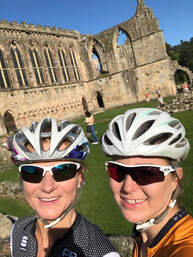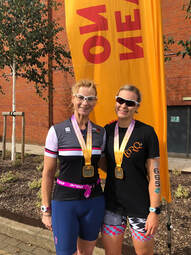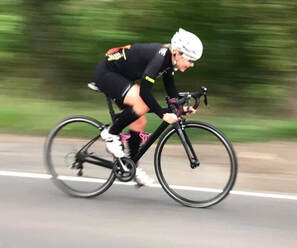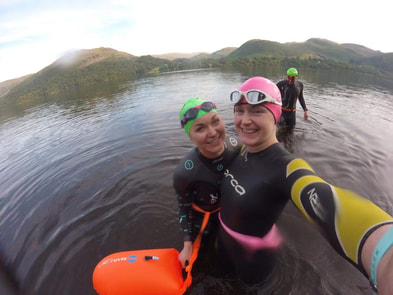|
These are definitely one of my most loved recipes. I honestly get asked to make them so often and they go in a flash at any event I take them to! Now you can have them whenever you want - the best thing, is they take about 5 minutes to whip up too!
If you aren't a fan of peanut butter, try it out with alternative nut butters - almond butter works really well too. Ingredients
Method
Enjoy! Hels x
0 Comments
I wasn't originally going to post this, but my mum said it may help others working towards their 2020 seasons too, so here you go!
Over the winter months, you tend to wind down the training and start putting plans together for the upcoming new season of racing. Being fairly new to triathlon, my mum asked me for a little bit of guidance to help her start planning her training in the new year - moving towards a more structured approach to hopefully make those all important performance improvements. I am obviously not a qualified coach, but from my own experience of structured training I gave her the following advice to help her formulate her own plan: Training plan length and number of sessions Most focused triathlon training plans for Sprint/Olympic distance triathlons are usually between 9-12 weeks long, so work this back from your 'A' race. Prior to starting your plan, I would focus on keeping base fitness up across the three disciplines, but nothing too intense, otherwise you can be at risk of over-training, getting fatigued/injured and losing motivation. During your training plan, generally most guidance says you should be doing approx. 2-3 sessions of each discipline, depending on your strengths and weaknesses. If you have limited time, you can combine sessions e.g. run to the pool, do a spin class followed by a run/ bike to the pool etc. Session types For a sprint distance triathlon I would say you would need, per week, at least one speed session for each discipline, a run endurance session, a bike endurance session, and a strength and conditioning session. Endurance - long, slower, continuous session (one bike and one run):
Speed – Interval training:
Strength and conditioning - performance enhancing strength training:
Key principles of training Keep these in mind so you don’t plateau:
Remember, this is very generic and you should tailor your own training plans to suit your own strengths/weaknesses, and if in doubt speak to a qualified coach. Hels x Surprise your friends with the mystery ingredient ‘black beans’ – they are a great non meat source of protein so a great addition to baking if you’re wanting to increase your protein intake – and surprisingly tasty in cookie form!
Ingredients:
Method:
Enjoy! Per cookie = ~190kcal, 22g carbs, 9g fat, 5g protein Hels x Following on from my last post about the benefits of a training plan and coaches, I am lucky enough to be able to share a guest post written by my coach Ben explaining how to utilise cross training to prevent and make the most of your training. Variety is the spice of lifeThe appeal and uptake of triathlon across running clubs over the past decade has been huge, with many seeing it as a next step for a number of reasons. From a pursuit of greater satisfaction from endurance sports to expanding their circle of sporting friends or simply achieving greater variety in training and racing. From a coach (who’s also gone down the path from runner to multi-sporter) it’s of benefit when a runner approaches me with the mindset of wanting to cross-train, whether it be limited to the months of their marathon plan or with further ambitions to do a multi-discipline event later in the season. The addition of another sport or two doesn’t necessarily have to be taken as a move to triathlon or take the form of joining a local cycling or swimming club. Fitting a weekly gym spin or swim into the schedule can easily reduce the cost and other perceived barriers. Being a runner who was initially larger than I would have liked to be, and due to resultant aches and pains could ‘only’ run a maximum of four times a week, the move to triathlon allowed me to make endurance strength gains through being able to train on non-running days (and as my experience developed, doubling up on running days with a morning swim or cycle). Avoidance of running-based injuries by no longer feeling that I needed to run more to improve was an immediate benefit, but crucially it did also require a new skill that would be common to us all: managing our schedules to navigate another pitfall of training more, mental and physical fatigue. Conservation of energyAlthough I’m enthusiastic to help integrate cross training sessions into athletes’ plans, it’s important from the perspective of both coach and athlete to understand whether this will move the performance needle or in actuality just be a further physical and emotional drain from what can already be a delicate work-life-sport balance. The addition has to be athlete-driven and its volume and intensity based on a combination of intelligent scheduling, effort management, and how self-aware the athlete is to their resilience, recovery, non-sporting commitments and work-life balance. For most club athletes, fitting in the weekly runs can already feel like a second job on top of the bill-paying one, alongside family, social life and other interests. The luxury of being a time-rich professional with the opportunity for daytime recovery, more frequent sports massages and physio contact time just isn’t possible for the amateur. Balancing life and physical ability against the desire to train like your Instagram professional triathlete heroes is therefore key in maximising A-race goals, whilst continuing to be a productive employee, parent, partner and friend. This is combined with understanding the physical and mental pay-back of additional sessions. Aiming for two weekly swims, missing two and under-performing on the third is a waste, is demoralising and (even worse) can affect running performance. The weeks between training plans (after some well earned rest and recovery!) can be a perfect time to test a new routine alongside your core sport, without the pressure of it continuing for three months. For such an experiment I’ll often get athletes to try a new routine two to four weeks before a plan kicks off (with a bit of rest before any adjustments and the plan begins in earnest). Additional session volume doesn’t have to be huge to understand how it’ll both fit into life and gain feedback on its impact. To summarise, although a multi-sport week can help reduce the risk of running injuries, it should also be understood whether complementary poorly managed sessions would result in fatigue, maintain fitness levels or optimally, improve performance. To do this it’s vital to use and understand your numbers. Train smartTogether with access to more training opportunities, the reduction in cost and the development in technology now gives athletes a plethora of performance metrics to train and race by. Heart rate measurements of effort and recovery, running and cycling cadence and bike power meters can all be utilised to ensure every session (or at least key ones) is completed to a beneficial level of stress. Using the time before a plan to measure metrics such as maximum heart rate and bike functional threshold power makes setting training efforts for all the sports and the feelings an athlete experiences throughout sessions considerably easier to control and understand. Was a session easier or harder than expected? If so, was there a reason for this (e.g. course and terrain, forthcoming or recent illness and fatigue)? For a start, find and dust off the heart rate strap that came free with your Garmin, then give it some use over the next few weeks and get in the habit of using it (as well as doing some research on understanding its numbers). A change is a good restHopefully this article has given you some ideas on where and how you could potentially benefit from running a bit less whilst still training a bit more. Changes don’t need to be permanent, but who knows, they could be so good you’ll never look back on your old ways of feeling like running more was the only way to run faster and further.
About the author: Ben Parkinson is an England Athletics Level 2 CiRF-qualified coach at the Spa Strider running club based in Leamington Spa, Warwickshire. Alongside ‘competing’ in running, cycling, duathlon and triathlons, he’s coached a range of local athletes including me (Hels). You can contact Ben by email and follow him on Strava: [email protected] strava.com/athletes/597069 |
AuthorAn everyday girl with a love of competition (and nut butter) Archives
October 2021
Categories |









 RSS Feed
RSS Feed
